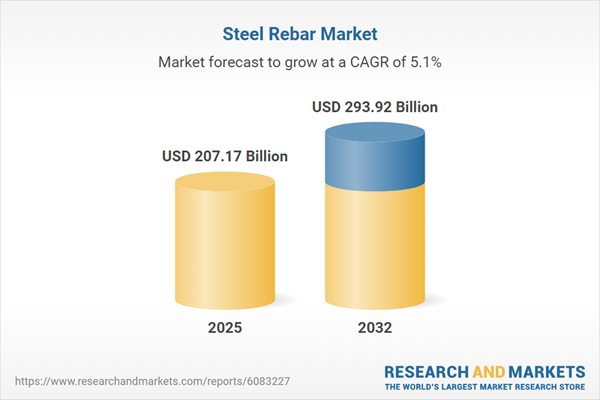Speak directly to the analyst to clarify any post sales queries you may have.
The steel rebar market is undergoing transformation as advanced technologies, regulatory developments, and evolving supply chains redefine construction standards. Senior decision-makers are navigating a complex environment where material innovation and sustainability requirements influence infrastructure priorities and competitive positioning.
Market Snapshot: Steel Rebar Market Growth and Trajectory
The steel rebar market expanded from USD 197.57 billion in 2024 to USD 207.17 billion in 2025. Projections indicate a compound annual growth rate (CAGR) of 5.09%, with the market forecast to reach USD 293.92 billion by 2032. Market momentum is supported by accelerated urbanization, resilient infrastructure investment, and new advancements in construction materials. In response to surging demand across civil engineering and building sectors, industry participants are investing in technological upgrades and prioritizing enhanced material performance. Modernization initiatives in both public infrastructure and private building segments continue to shape the market’s forward trajectory.
Scope & Segmentation
- Product Types: Includes deformed bars such as Cold Twisted Deformed and Thermo-Mechanically Treated varieties, and plain bars, accommodating a spectrum of technical and design needs.
- Materials: Alloy steel rebar, carbon steel rebar, glass fiber reinforced polymer (GFRP) rebar, and stainless steel rebar provide specialized solutions for diverse project requirements.
- Process Types: Cold rolled and hot rolled processes deliver tailored structural solutions for infrastructure, adapting to various operational challenges in the construction sector.
- Bar Sizes: Less than 10 mm, between 10–32 mm, and more than 32 mm, supporting precise applications across different structural loads and design specifications.
- Applications: Bridges, flyovers, highways, roads, marine structures, prefabricated concrete components, reinforced concrete, tunnels, and dams reflect the broad utility across public and private projects.
- End-Use Industries: Commercial, institutional, industrial, and residential construction each set unique benchmarks for safety, durability, and compliance.
- Regions: Americas (including United States, Canada, Mexico, Brazil, Argentina, Chile, Colombia, Peru), Europe (United Kingdom, Germany, France, Russia, Italy, Spain, Netherlands, Sweden, Poland, Switzerland), Middle East (United Arab Emirates, Saudi Arabia, Qatar, Turkey, Israel), Africa (South Africa, Nigeria, Egypt, Kenya), and Asia-Pacific (China, India, Japan, Australia, South Korea, Indonesia, Thailand, Malaysia, Singapore, Taiwan) illustrate distinct market drivers and regulatory variations.
Comprehensive segmentation enables manufacturers and suppliers to streamline strategies, target opportunities, and allocate resources efficiently across both established and emerging markets.
Key Takeaways for Steel Rebar Market Stakeholders
- Adoption of thermo-mechanical treatment enhances mechanical strength, supporting seismic resistance and optimized digital construction processes.
- Broader use of stainless steel and GFRP materials is advancing rebar deployment in corrosion-prone applications, especially for marine and critical infrastructure projects.
- Process digitalization and increased automation drive quality improvements, reduce operational downtime, and support efficiency throughout project phases.
- Regulatory action on environmental sustainability and emissions intensifies focus on life cycle assessments for procurement and supply chain decisions.
- Flexible production methods and bar size segmentation allow for precise infrastructure responses, from prefabricated modular systems to complex tunnel structures.
Tariff Impact: United States 2025 Rebar Trade Policy
Recent tariff developments in the United States for 2025 have reshaped the competitive context, incentivizing domestic steel rebar production and compelling importers to re-evaluate sourcing methods. These policy adjustments are exerting upward pressure on delivered costs for some rebar segments. In response, domestic manufacturers are expanding in-country capabilities and revising supply contracts, while exporters shift their focus toward regions with more accommodating tariffs. These dynamics are intensifying competitive activity in Asia-Pacific, Europe, and the Middle East. As supply chains adjust, market participants must address changes in sourcing strategies, risk, and supply resilience.
Methodology & Data Sources
This assessment combines systematic secondary research, interviews with industry experts, and quantitative analysis. Robustness of findings is ensured through data triangulation, validation sessions, and scenario-based evaluation across all addressed market segments and geographies.
Why This Report Matters
- Enables benchmarking with global and regional trends, aligning decision-making with regulatory change and shifting sector priorities.
- Supports risk and opportunity analysis through in-depth segmentation and evaluation of technology adoption across value streams.
- Provides a foundation for refining operational and procurement strategies within fast-evolving supply chains and regulatory landscapes.
Conclusion
Maintaining a leadership position in the steel rebar market depends on integrating new technologies, advancing sustainability, and achieving flexibility in supply chain operations. This analysis offers actionable insight to inform strategies for sustainable growth and resilience in a changing industry.
Table of Contents
3. Executive Summary
4. Market Overview
7. Cumulative Impact of Artificial Intelligence 2025
Companies Mentioned
The companies profiled in this Steel Rebar market report include:- ArcelorMittal S.A.
- Nucor Corporation
- Acerinox S.A.
- CELSA Group
- Commercial Metals Company
- Daido Steel Co., Ltd.
- Gerdau S/A
- HBIS Group
- Hyundai Steel Co., Ltd.
- JSW Steel
- Nippon Steel Corporation
- Puget Sound Steel Company
- Riva Forni Electrici S.p.A.
- SAIL
- Stecol International Pvt. Ltd.
- Steel Dynamics, Inc.
- Steelex Inc.
- Tata Steel Limited
Table Information
| Report Attribute | Details |
|---|---|
| No. of Pages | 196 |
| Published | November 2025 |
| Forecast Period | 2025 - 2032 |
| Estimated Market Value ( USD | $ 207.17 Billion |
| Forecasted Market Value ( USD | $ 293.92 Billion |
| Compound Annual Growth Rate | 5.0% |
| Regions Covered | Global |
| No. of Companies Mentioned | 19 |









